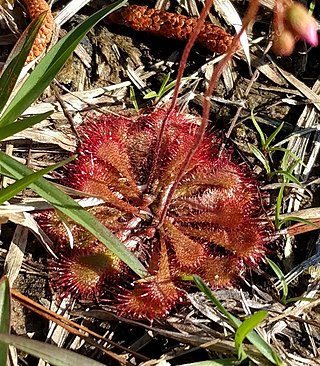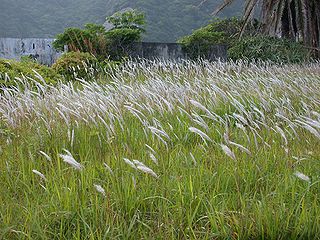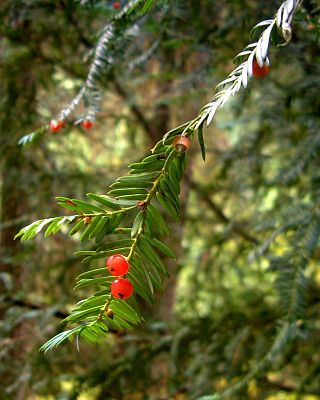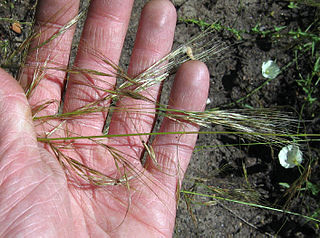
Yucca brevifolia is a plant species belonging to the genus Yucca. It is tree-like in habit, which is reflected in its common names: Joshua tree, yucca palm, tree yucca, and palm tree yucca.

Drosera brevifolia, is a carnivorous plant of the family Droseraceae and is the smallest sundew species native to the United States. This species differs considerably from the pink sundew, Drosera capillaris, by its wedge-shaped leaves, and distinctly deeper red to reddish purple color, noticeable when side by side with D. capillaris.

Imperata cylindrica is a species of perennial rhizomatous grass native to tropical and subtropical Asia, Micronesia, Melanesia, Australia, Africa, and Southern Europe. It has also been introduced to Latin America, the Caribbean, and the Southeastern United States. It is a highly flammable pyrophyte, and can spread rapidly by colonizing disturbed areas and encouraging more frequent wildfires.

Taxus brevifolia, the Pacific yew or western yew, is a species of tree in the yew family Taxaceae native to the Pacific Northwest of North America. It is a small evergreen conifer, thriving in moisture and otherwise tending to take the form of a shrub.

Nassella pulchra, basionym Stipa pulchra, is a species of grass known by the common names purple needlegrass and purple tussockgrass. It is native to the U.S. state of California, where it occurs throughout the coastal hills, valleys, and mountain ranges, as well as the Sacramento Valley and parts of the Sierra Nevada foothills, and Baja California.

Imperata is a small but widespread genus of tropical and subtropical grasses, commonly known as satintails.

Lycium andersonii is a species of flowering plant in the nightshade family, Solanaceae. Its common names include water-jacket, redberry desert-thorn, Anderson thornbush, Anderson's desert thorn, Anderson boxthorn, Anderson lycium, Anderson wolfberry, and squawberry.

Anthoxanthum occidentale is a species of grass known by the common name California sweetgrass. It is a close relative of the more widely known sweet grass. It is native to the west coast of the United States from Washington to California, where it grows in the coniferous forests of the coastal mountain ranges. This is a rhizomatous perennial grass with leaves up to 30 centimeters long and 1.5 wide. The stem reaches a meter in height with an inflorescence of 7 to 10 centimeters. The spikelets grow on short, wavy stalks and each has three florets with long, protruding stamens during flowering.

Hulsea brevifolia is a species of flowering plant in the family Asteraceae known by the common name shortleaf alpinegold, or shortleaf hulsea. It is endemic to California, where it is an uncommon resident of the High Sierra. It is found between 6,000–8,000 feet (1,800–2,400 m) in elevation.

Hesperevax sparsiflora is a species of flowering plant in the family Asteraceae known by the common name erect dwarf cudweed. It is native to California and Oregon, where it grows in several habitat types including sandy coastal areas and the serpentine soils of inland hills. This is a small woolly annual herb reaching maximum heights under 18 centimeters. It has oval to rounded or scoop-shaped leaves on short petioles which vary in morphology across varieties. Small flower heads appear between the leaves. They contain greenish or whitish disc florets.

Cordylanthus rigidus is a species of flowering plant in the family Orobanchaceae known by the common name stiffbranch bird's beak.

Stipa coronata, formerly classified as Achnatherum coronatum, is a greenish species of grass known by the common name crested needlegrass, giant ricegrass, and giant stipa.

Stipa parishii, formerly classified as Achnatherum parishii, is a species of grass known by the common name Parish's needlegrass. The Jepson Manual 2nd edition (2012) reclassified the plant as Stipa parishii var. parishii.

Alopecurus saccatus is a species of grass known by the common name Pacific foxtail, or Pacific meadow foxtail.

Arctostaphylos montaraensis, known by the common name Montara manzanita, is a species of manzanita in the family Ericaceae.

Calochortus amabilis is a species of the genus Calochortus in the family Liliaceae. It is also known by the common names Diogenes' lantern, yellow globe-tulip, golden globe-tulip, yellow globe lily, golden fairy lantern, golden lily-bell, Chinese lantern, and short lily.

Muhlenbergia richardsonis, known by the common name mat muhly, is a species of grass. It is native to North America, where it can be found throughout much of Canada, Alaska, the western half of the contiguous United States through California, and in Baja California, Mexico.

Parnassia californica is a species of flowering plant in the family Celastraceae known by the common name California grass of Parnassus. It is native to the mountains of Oregon, California, and Nevada, where it grows in moist areas such as meadows and streambanks.
Crotalaria avonensis is a rare species of flowering plant in the legume family known by the common names Avon Park rattlebox, Avon Park harebells, and Avon Park rabbit-bells. It is endemic to Central Florida in the United States, where it is known from only three sites. Many individuals exist on land that is unprotected and they are threatened with destruction. The plant is a federally listed endangered species.

Nassella lepida is a species of grass known by the common names foothill needlegrass, foothills nassella, foothill stipa, small-flowered stipa, small-flowered needlegrass, and smallflower tussockgrass.



















